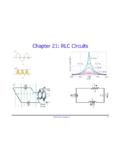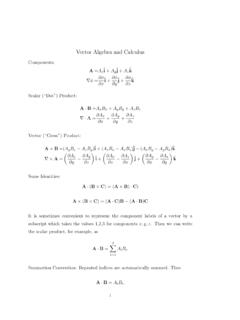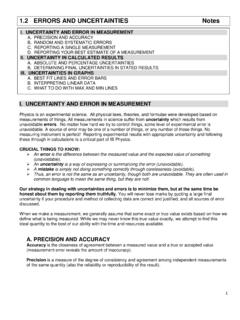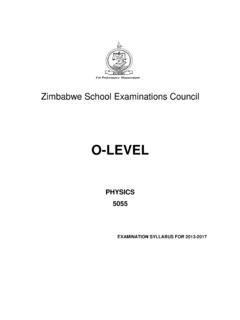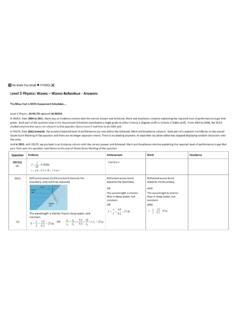Transcription of 1 Range of Projectile Motion - Department of Physics at UF
1 AbstractThese lecture notes supplements my discussion class. We only haveone session per week and normally we have to rush through one wholechapter in less than 50 minutes. Now I believe supplementary notes arenecessary for you to further your understanding in Physics on your topic is independent. So you can just start with the section thatinterests you. Some topics are very basic, so I hope everyone will readthem. Others are advanced, which often exceeds the textbook level. So ifyou feel the course is too easy and you re bored, try challenging problemsI provide in these Range of Projectile Horizontal RangeMost of the basic Physics textbooks talk about the horizontal Range of theprojectile Motion . It is derived using the kinematics equations:ax= 0vx=v0x x=v0xtay= gvy=v0y gt y=v0yt 12gt2wherev0x=v0cos v0y=v0sin Suppose a Projectile is thrown from the ground level, then the Range is thedistance between the launch point and the landing point, where the projectilehits the ground.
2 When the Projectile comes back to the ground, the verticaldisplacement is zero, thus we have0 =v0sin t 12gt2 Solving fort, we havet= 0,2v0sin g1 The first solution gives the time when the Projectile is thrown and the secondone is the time when it hits the ground. Plugging in the second solution intothe displacement equation and using 2 sin cos = sin(2 ), we haveR= x(t= 2v0sin /g) =v20gsin(2 )ExampleA baseball player can throw a ball at m/s. What is the maximumhorizontal Range ?SolutionTo maximize the Range , s/he must throw a ball at an angle of 45 becauseat this angle sin 2 = Range isR=v20g= Range on a SlopeNow what happens if you throw a ball on a slope? Do you still need to throw aball at 45 above the horizontal to maximize the Range ?
3 Or should you throwat 45 to the slope? Neither of them is correct. If you throw a ball at 45 ona slope of, say, 60 , then you re practically throwing the balltowardthe slopeso the Range is actully zero. (We ignored the height of the launch point.) If youthrow a ball at an angle of 45 to the slope of 45 , you re actually throwing aball straight up, and the Range is again we modify our theory for the horizontal Range and derive the Range of aprojectile on a slope. Assuming a Projectile is launched from the ground level,the Range is defined as the distance between the launch point and the pointwhere the Projectile hits the ground. We take +xdirection horizontally and+yvertially upward, so that we can still use our kinematic slope of angle is expressed as y= tan x, and when the projectilehits the ground, the horizontal displacement and vertical displacement of theprojectile must satisfy this relationship.
4 Thus we havev0sin t 12gt2= tan (v0cos t)Solutions for this equations aret= 0,2v0g(sin tan cos )The second solution gives the time at which the Projectile hits the this into the equation for x, we get x=v0cos t=v0cos [2v0g(sin tan cos )]2We haven t reached the solution yet. We just got horizontal displacement, notthe Range on the slope. The Range on slope is given byR= x2+ y2= x2+ (tan x)2= xcos where we used the trig identity 1 + tan2 =1cos2 . Thus we getR=2v20cos gcos (sin tan cos ) =2v20cos gcos (sin cos sin cos cos )=2v20cos sin( )gcos2 =v20gcos2 [sin(2 ) sin ]where we used trig identity sin(a b) = sinacosb cosasinb. You must notethis reduces to the expression of horizontal Range at = baseball player throws a ball on a 20 slope toward the top of the can throw a ball at a speed of 30 m/s.
5 What is the maximum Range ?(Ignore the height of the launch point.)SolutionIn our expression for the Range , the second term is constant. Thus we needto maximize the first term. It is achieved whensin(2 ) = 12 = 90 =90 + 2=90 + 202= 55 So s/he needs to throw a ball at an angle 55 to the horizontal( 35 to theincline). The Range with this projection angle isR=v20gcos2 [1 sin ] = cos220 [1 sin 20 ] = mThe Range on a slope is shorter than that on a level is the Range if the baseball player throws a ball toward the bottom ofthe slope(The inclination is 20 )?2 Choice of Coordinate SystemBefore applying Newton s 2nd law to a given problem, you need to fix yourcoordinate system. We have one solid principle when we choose a one of the axes along the direction of is becausewith this coordinate system, the acceleration along the other axis is zero.
6 Thissimplifies our algebra a block with massmis sliding down a slope of angle . The coefficient ofkinetic friction between the slope and the block is k. Find the acceleration ofthe 1We take +xaxis along and down the slope and +yaxisperpendicular to the surface, in this coordinate system,ycomponent of theacceleration is zero. Theycomponent of the equation of Motion is0 =N mgcos N=mgcos The kinetic friction is given byfk= kN. Applying the Newton s 2nd law inthe x direction, we havema=mgsin fk=mgsin k(mgcos )a=g(sin kcos )Solution 2We take +xdirection horizontally and +yaxis vertically this coordinate system,xandycomponents of the equation of Motion are,respectively,macos =Nsin kNcos masin =Ncos + kNsin mgwhere kN=fk.
7 First we solve each equation forNto removeNfrom thesimultaneous sin kcos N=mg masin cos + ksin Then we equate them, and solve sin kcos =mg masin cos + ksin acos (cos + ksin ) = (g asin )(sin kcos )a(cos2 + sin2 ) =g(sin kcos )a=g(sin kcos )where we used trigonometric identity cos2 + sin2 = 1. Now are you con-vinced? No? Let s see another

